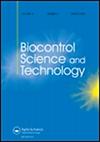Study on the control potential of Alternaria alternata against four species of weeds in agricultural fields on the Tibetan Plateau
IF 1.2
4区 农林科学
Q4 BIOTECHNOLOGY & APPLIED MICROBIOLOGY
引用次数: 0
Abstract
ABSTRACT The aim of this study was to investigate the potential and pathogenic mechanism of the pathogenic fungus Alternaria alternata strain GD-011-B against four major agricultural weeds on the Tibetan plateau, and to lay a foundation for the commercial production and application of this strain. The mycelial masses had herbicidal activity against the isolated leaves of the weeds Chenopodium album, Elsholtzia densa, Malva verticillata, and Amaranthus retroflexus L., with a descending herbicidal activity order of M. verticillata > E. densa > A. retroflexus > C. album. The fermentation broth also showed herbicidal activity by treating the whole plants of these four weeds in the descending order of C. album > E. densa > M. verticillata > A. retroflexus. Scanning electron microscopy revealed that GD-011-B mycelia invaded the inner part of the leaf of A. retroflexus through the stomata and epidermal tissue gap and extended to the back, damaging the leaf epidermis and tissues and sporulating on the leaf surface, ultimately resulting in leaf disease. The fermentation broth of pathogen GD-011-B was not pathogenic to Vicia faba L., Pisum sativum L., Hordeum vulgare L., or Triticum aestivum L., but it was slightly pathogenic to Brassica napus L. Therefore, Alternaria alternata can be used as a herbicidal microorganism with high potential for biological control of four major agricultural weeds on the Tibetan plateau.青藏高原稻交霉对4种农田杂草的防治潜力研究
摘要本研究旨在探讨青藏高原稻交霉(Alternaria alternata)病原菌GD-011-B对4种主要农业杂草的拮抗潜力及致病机制,为该菌株的商业化生产和应用奠定基础。该菌丝团对藜草、密穗草、黑麦草和红苋菜的离体叶片均有除草活性,除草活性由大到小依次为黑麦草>黑麦草。densa > A;C。专辑。发酵液对四种杂草的全株处理均表现出除草活性,处理效果从大到小依次为C. album > E.。密度> M。A;retroflexus。扫描电镜结果显示,GD-011-B菌丝体通过气孔和表皮组织间隙侵入回曲叶内部,向叶后延伸,破坏叶片表皮和组织,在叶表面产生孢子,最终导致叶片病害。病原菌GD-011-B发酵液对蚕豆、油菜、普通Hordeum vulgare L.和小麦无致病性,但对甘蓝型油菜有轻微致病性,因此,互交霉可以作为一种具有较高生物防治潜力的除草微生物。
本文章由计算机程序翻译,如有差异,请以英文原文为准。
求助全文
约1分钟内获得全文
求助全文
来源期刊
CiteScore
3.20
自引率
7.10%
发文量
64
审稿时长
4-8 weeks
期刊介绍:
Biocontrol Science and Technology presents original research and reviews in the fields of biological pest, disease and weed control. The journal covers the following areas:
Animal pest control by natural enemies
Biocontrol of plant diseases
Weed biocontrol
''Classical'' biocontrol
Augmentative releases of natural enemies
Quality control of beneficial organisms
Microbial pesticides
Properties of biocontrol agents, modes of actions and methods of application
Physiology and behaviour of biocontrol agents and their interaction with hosts
Pest and natural enemy dynamics, and simulation modelling
Genetic improvement of natural enemies including genetic manipulation
Natural enemy production, formulation, distribution and release methods
Environmental impact studies
Releases of selected and/or genetically manipulated organisms
Safety testing
The role of biocontrol methods in integrated crop protection
Conservation and enhancement of natural enemy populations
Effects of pesticides on biocontrol organisms
Biocontrol legislation and policy, registration and commercialization.

 求助内容:
求助内容: 应助结果提醒方式:
应助结果提醒方式:


